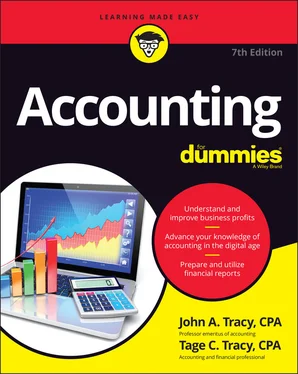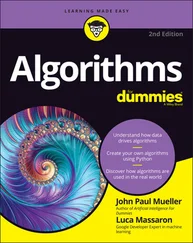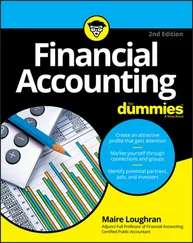John A. Tracy - Accounting For Dummies
Здесь есть возможность читать онлайн «John A. Tracy - Accounting For Dummies» — ознакомительный отрывок электронной книги совершенно бесплатно, а после прочтения отрывка купить полную версию. В некоторых случаях можно слушать аудио, скачать через торрент в формате fb2 и присутствует краткое содержание. Жанр: unrecognised, на английском языке. Описание произведения, (предисловие) а так же отзывы посетителей доступны на портале библиотеки ЛибКат.
- Название:Accounting For Dummies
- Автор:
- Жанр:
- Год:неизвестен
- ISBN:нет данных
- Рейтинг книги:3 / 5. Голосов: 1
-
Избранное:Добавить в избранное
- Отзывы:
-
Ваша оценка:
- 60
- 1
- 2
- 3
- 4
- 5
Accounting For Dummies: краткое содержание, описание и аннотация
Предлагаем к чтению аннотацию, описание, краткое содержание или предисловие (зависит от того, что написал сам автор книги «Accounting For Dummies»). Если вы не нашли необходимую информацию о книге — напишите в комментариях, мы постараемся отыскать её.
Accounting For Dummies
Accounting For Dummies — читать онлайн ознакомительный отрывок
Ниже представлен текст книги, разбитый по страницам. Система сохранения места последней прочитанной страницы, позволяет с удобством читать онлайн бесплатно книгу «Accounting For Dummies», без необходимости каждый раз заново искать на чём Вы остановились. Поставьте закладку, и сможете в любой момент перейти на страницу, на которой закончили чтение.
Интервал:
Закладка:
3 Close the books — bring the bookkeeping for the fiscal year just ended to a close and get things ready to begin the bookkeeping process all over again for the coming fiscal year. Books is the common term for a business’s complete set of accounts . (Well, okay, we should include journal entries in the definition of books, but you get the point.) A business’s transactions are a constant stream of activities that doesn’t end tidily on the last day of the year, which can make preparing financial statements and tax returns challenging. The business has to draw a clear line of demarcation between activities for the year (the 12-month accounting period) ended and the year yet to come by closing the books for one year and starting with fresh books for the next year.
 Most medium-sized and larger businesses prepare an internal accounting manual or set of policies and procedures that spells out in great detail the specific accounts and procedures for recording transactions. A business should regularly review its chart of accounts and accounting rules and policies and make revisions. Companies do not take this task lightly; discontinuities in the accounting system can be major shocks and have to be carefully thought out. Nevertheless, bookkeeping and accounting systems can’t remain static for very long. If these systems were never changed, bookkeepers would still be sitting on high stools making entries with quill pens and bottled ink in leather-bound ledgers.
Most medium-sized and larger businesses prepare an internal accounting manual or set of policies and procedures that spells out in great detail the specific accounts and procedures for recording transactions. A business should regularly review its chart of accounts and accounting rules and policies and make revisions. Companies do not take this task lightly; discontinuities in the accounting system can be major shocks and have to be carefully thought out. Nevertheless, bookkeeping and accounting systems can’t remain static for very long. If these systems were never changed, bookkeepers would still be sitting on high stools making entries with quill pens and bottled ink in leather-bound ledgers.
Managing Accounting Systems
In our experience, too many business managers and owners ignore their bookkeeping and accounting systems or take them for granted — unless something goes wrong. They assume that if the books are in balance, everything is okay, and that you can simply hit a print report icon or button to produce qualify financial information. The later section “ Double-Entry Accounting” covers exactly what it means to have “books in balance” — it does not necessarily mean that everything is okay.
To determine whether your bookkeeping system is up to snuff, check out this section, which provides a checklist of the most important elements of a good system.
Categorize financial information: The chart of accounts
Suppose that you’re the accountant for a corporation and you’re faced with the daunting task of preparing the annual federal income tax return for the business. The Internal Revenue Service (IRS) requires that you report the following expenses (and this list contains just the minimum!):
Advertising
Bad debts
Charitable contributions
Compensation of officers
Cost of goods sold
Depreciation
Employee benefit programs
Interest
Pensions and profit-sharing plans
Rents
Repairs and maintenance
Salaries and wages
Taxes and licenses
You must provide additional information for some of these expenses. For example, the cost of goods sold expense is determined in a schedule that also requires inventory cost at the beginning of the year, purchases during the year, cost of labor during the year (for manufacturers), other costs, and inventory cost at year-end.
Where do you start? Well, if it’s March 1 and the corporate tax return deadline is March 15, you start by panicking — unless you were smart enough to think ahead about the kinds of information your business would need to report. In fact, when your accountant first designs your business’s accounting system, they should dissect every report to managers, the external financial statements, and the tax returns, breaking down all the information into basic account categories such as those we just listed.
 For each category of information that you need to include in an accounting report, you need an account (or a group of accounts), which is a record of the activities in that category. An account is basically a focused history of a particular dimension of a business. Individuals can have accounts, too — for example, your checkbook (physical or digital) is an account of the cash inflows and outflows and the balance of your checking account (assuming that you remember to record all activities and reconcile your checkbook against your bank statement). We doubt that you keep a written account of the coin and currency in your wallet, pockets, glove compartment, and sofa cushions, but a business needs to keep track of all its cash, no matter where it is. An account serves as the source of information for preparing financial statements, tax returns, and reports to managers.
For each category of information that you need to include in an accounting report, you need an account (or a group of accounts), which is a record of the activities in that category. An account is basically a focused history of a particular dimension of a business. Individuals can have accounts, too — for example, your checkbook (physical or digital) is an account of the cash inflows and outflows and the balance of your checking account (assuming that you remember to record all activities and reconcile your checkbook against your bank statement). We doubt that you keep a written account of the coin and currency in your wallet, pockets, glove compartment, and sofa cushions, but a business needs to keep track of all its cash, no matter where it is. An account serves as the source of information for preparing financial statements, tax returns, and reports to managers.
The term general ledger refers to the complete set of accounts established and maintained by a business. The chart of accounts is the formal index of these accounts — the complete listing and classification of the accounts used by the business to record its transactions. General ledger usually refers to the actual accounts and often to the balances in those accounts at some particular time. The chart of accounts, even for a relatively small business, contains more than 100 accounts. Larger business organizations need thousands of accounts. The larger the number, the more likely that the accounts are given number codes according to some scheme — for example, all assets may be in the 100 to 300 range; all liabilities, in the 400 to 500 range; and so on.
 As a business manager, you should make sure that the controller (chief accountant) or perhaps an outside CPA consultant reviews the chart of accounts periodically to determine whether the accounts are up to date and adequate for the business’s needs. Over time, income tax rules change, business economic models evolve, the company goes into new lines of business, the company adopts new employee benefit plans, and so on. Most businesses are in constant flux, and the chart of accounts has to keep up with these changes.
As a business manager, you should make sure that the controller (chief accountant) or perhaps an outside CPA consultant reviews the chart of accounts periodically to determine whether the accounts are up to date and adequate for the business’s needs. Over time, income tax rules change, business economic models evolve, the company goes into new lines of business, the company adopts new employee benefit plans, and so on. Most businesses are in constant flux, and the chart of accounts has to keep up with these changes.
Standardize source documents and data-entry procedures for recording activities
Just like you need a constant circulation of blood to live, businesses need a constant flow of paperwork and electronic activity. Even in this age of the internet and the cloud, electronic communication, and computers, a business generates and depends on lots of documentation (either hard paperwork or digitized documents in PDFs). And much of this documentation is used in the accounting process. Placing an order to buy products, selling a product to a customer, determining the earnings of an employee for the month — virtually every business transaction needs some documentation, generally called source documents. When you pay a bill, for example, don’t you want a “hard copy” to examine before you write the check?
Source documents serve as legal evidence of the terms and conditions agreed upon by the business and the other person or organization that it’s dealing with. Both parties receive some kind of source document. For example, for a sale at a cash register, the customer gets a sales receipt, and the business keeps a running record of all the transactions in the register, which can be printed out later if need be.
Clearly, an accounting system needs to standardize the forms and procedures for processing and recording all normal, repetitive transactions and should control the generation and handling of these source documents. From the bookkeeping point of view, these business forms and documents are important because they provide the input information needed for recording transactions in the business’s accounts. Sloppy paperwork leads to sloppy accounting records, and sloppy accounting records just won’t do when the time comes to prepare tax returns and financial statements.
Читать дальшеИнтервал:
Закладка:
Похожие книги на «Accounting For Dummies»
Представляем Вашему вниманию похожие книги на «Accounting For Dummies» списком для выбора. Мы отобрали схожую по названию и смыслу литературу в надежде предоставить читателям больше вариантов отыскать новые, интересные, ещё непрочитанные произведения.
Обсуждение, отзывы о книге «Accounting For Dummies» и просто собственные мнения читателей. Оставьте ваши комментарии, напишите, что Вы думаете о произведении, его смысле или главных героях. Укажите что конкретно понравилось, а что нет, и почему Вы так считаете.












